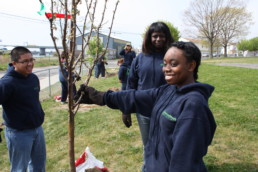Deep Greening: Using the Power of Nature to Create a Healthier, More Sustainable Bridgeport, CT
Year Complete: 2018
Grant Amount: $45,138
Local Government: City of Bridgeport, CT
Local Foundation: Emily Hall Tremaine Foundation
Project Purpose
To develop a community-led, neighborhood-scale Deep Greening plan to guide investments in trees, open space, and green stormwater infrastructure.
Key Lessons Learned
To develop a community-led, neighborhood-scale Deep Greening plan to guide investments in trees, open space, and green stormwater infrastructure.
Key Lessons Learned
Lessons learned about tools and tactics through the project that other sustainability directors could use to advance their work.
By combining community planning with on-the-ground action, the Project was an ambitious approach to neighborhood “greening.” With only slight changes to the Project’s scope, the Project Team learned that this type of ambition is achievable. Specific lessons include:
1) Community Survey: The Project Team’s approach to the survey – to explore the complexities of the word “nature” – allowed for an honest exploration of how to best engage community members in tree plantings and other nature-based initiatives. It was critical to know that shade was viewed as the number-one benefit of trees.
2) Places: As a neighborhood-based project, the importance of places – from a street corner to a
community center – was at the center of the work. The Project Team was both at awe with how quickly some new relationships blossomed (Hall Neighborhood House and Beardsley Elementary), while cognizant of the time it takes to build trust and develop authentic partnership.
3) Community Support: As envisioned, residents receiving a new tree were eager to sign-up as well as to help with planting. There were numerous powerful interactions with people and the rapid transformation of their landscape.
4) Process: The project’s commitment to action while planning helped engage a range of partners.
Bridgeport has embarked on many planning efforts recently, and structuring this project as leading with action helped to avoid losing engagement due to “planning fatigue.”
5) Community Input: The Project Team presented on the Deep Greening Vision throughout the course of the one-year timeline and gained valuable feedback. This structure provided opportunities to strengthen relationships.
6) Mayor’s Support: Despite the challenges of a changing city government/administration, the Project Team was encouraged by Mayor Ganim’s commitment to the effort, demonstrated by a “proclamation” honoring tree plantings in the East Side.
7) Program Expansion: The partnership between the City of Bridgeport and the Tremaine Foundation proved to be a successful model in the East Side. The East Side Deep Greening Vision is a valuable tool to guide future investment and The Nature Conservancy’s work, while the tree planting and GSI design established trust and legitimacy in the neighborhood. The Project Team had discussions with local leaders from the adjacent neighborhood of the East End to expand the Deep Greening model there.
Lessons for developing a collaborative process between a local government sustainability director and local place-based foundation(s).
Involve the community early and often. Demonstrate action, if only on a small scale, during the planning process.
Additional Information and Resources
The Deep Greening effort was successful and laid the foundation for two new strategic small grants. A profile on each of these initiatives can be found here and here.

